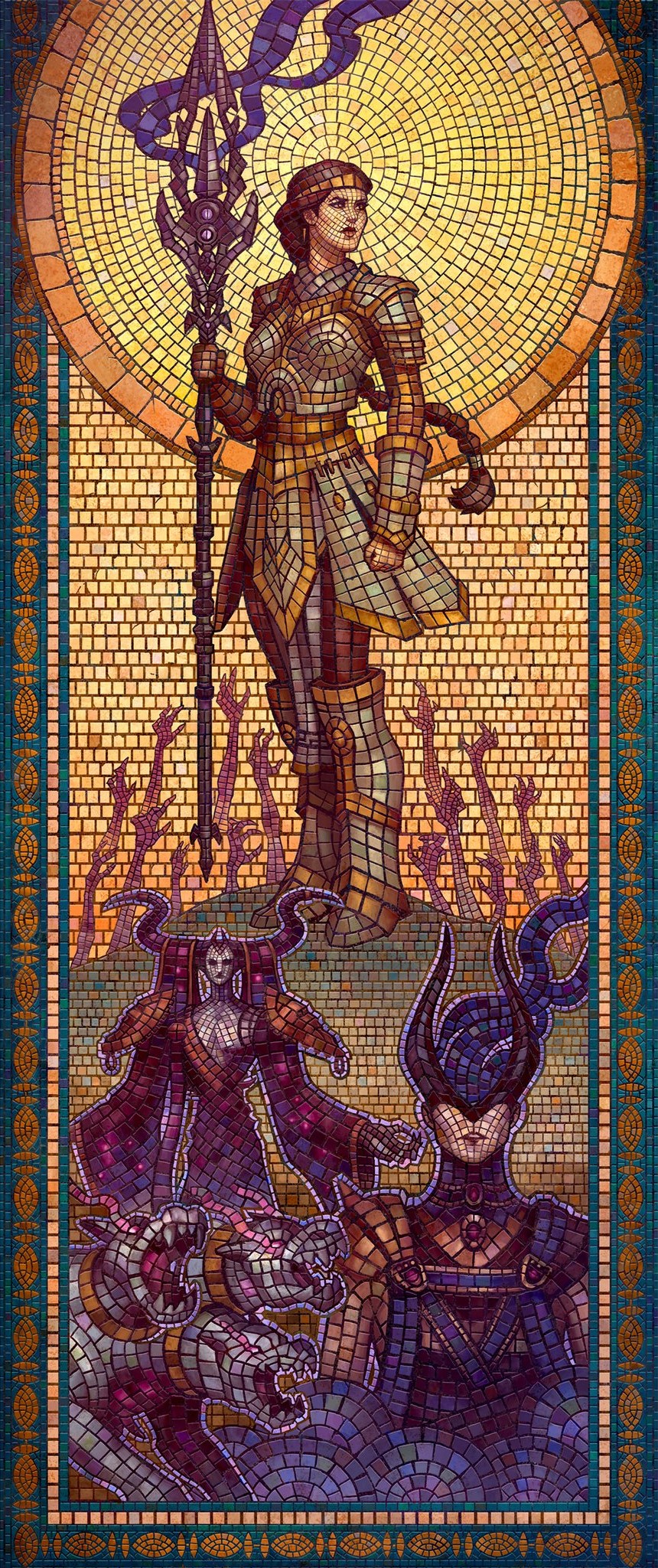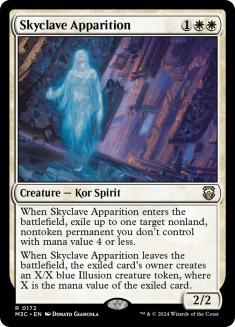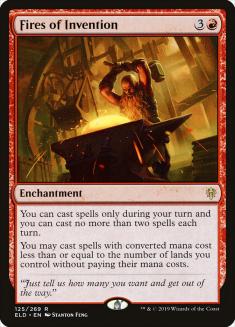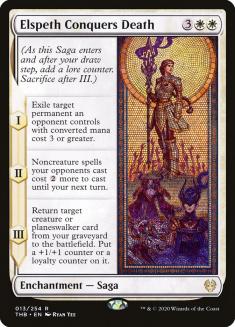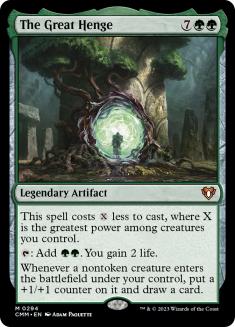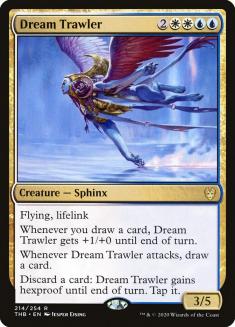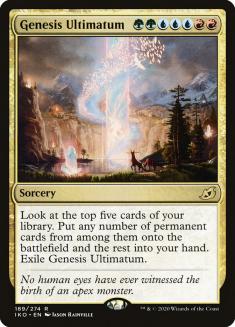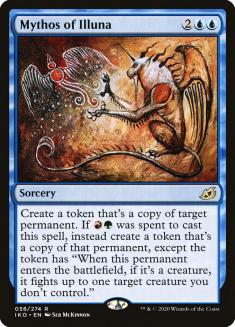At the risk of tempting fate… Standard is good again?!
As someone fortunate enough to cover a lot of Standard for the SCG Tour Online over its first two seasons, I quickly grew tired of yet another high-profile tournament being derailed by a stale Standard. There’s certainly a type of player who enjoys small, well-defined formats where you can tune the best deck week after week in search of mastery, and I had the privilege of watching the game’s best show just how intricate Temur Reclamation mirrors could be. That said, I always knew I was in the minority there and I was happy to take that loss if it meant the viewing public would be happy — and, more importantly, viewing. Instead, the monkey’s paw bequeathed us a format that was even more ridiculously warped but without anything interesting to redeem it.
A new dawn has broken and this third edition of Zendikar Rising Standard is starting to take shape. Every deck is doing something abstractly powerful, making it tough to weigh up which of those ideas is ‘better’ in an absolute sense. Anybody who has tried building decks during preview season knows that few of them survive a collision with reality in an initial testing session — and those lucky few are not always the ones you’d expect. With so many promising ideas and so little time, it’s useful to find immediate litmus tests that any candidate must pass:
Cheap interaction that trades up on mana for the same number of cards is a common safeguard against any deck becoming too strong — or, in recent Standard, against a new contender to the throne mounting a real challenge. Anyone hoping to compete with Simic Food, Temur Reclamation, or Sultai Ramp not only had the impossible task of matching them on the fundamentals but also had to keep up once powerful sideboard hammers like Aether Gust or Mystical Dispute joined the fray.
A shared factor behind these decks’ dominance was that they minimized their own vulnerability to these cards — as much as any deck in their colours could — while being structurally better-equipped to use them than their opponents. Similarly, many decks could call themselves favoured in Game 1 against Temur Energy thanks to some noncreature threat that became unreliable in sideboard games against a full clip of Negates. As formats become warped around one or two strategies and winning mirrors becomes all-important, it’s easier to justify maindecking these seemingly narrow effects.
While Negate is always around and Aether Gust has come and gone, Mystical Dispute remains legal and relevant in Zendikar Rising Standard. Any blue-heavy deck must be built with this card in mind and its success is self-perpetuating as the best way to punch through opposing Disputes is packing your own. In a world without Uro, Titan of Nature’s Wrath and Omnath, Locus of Creation it’s unlikely to make maindecks but I’m not keen to tempt fate there either. In Zendikar Rising Standard’s emerging arms race, Mystical Dispute is waiting to clip the wings of any expensive blue cards — Yorion, Sky Nomad and Dream Trawler will feature prominently in this discussion -—that fly above their station.
Bonecrusher Giant is the most obvious litmus test for any creature deck in Zendikar Rising Standard. Cards that remove creatures while leaving something behind have always placed severe constraints on what’s possible in these smaller formats, from Flametongue Kavu two decades ago through Teferi, Time Raveler last month with a lot of Reflector Mages in between. Anything that gets cleanly flattened by Stomp needs Lotus Cobra levels of upside to be playable — and Lotus Cobra only gets away with it because there are few other good Stomp targets in the decks it shines in.
Accomplished attackers like Aaron Barich and Zach Kiihne have tried to stitch together aggro decks that minimize their weakness to Bonecrusher Giant by cutting cards like Robber of the Rich, but the limits of this approach become apparent very quickly. In a creature synergy deck that leans on fragile enablers, this may be impossible — there’s no shortage of eye-catching cards that work with +1/+1 counters, but there’s a lethal lack of a third point of toughness for Conclave Mentor. To make matter worse, the natural homes for Bonecrusher Giant boast other inherent strengths against aggro — Gruul Adventures has more large roadblocks like Lovestruck Beast, while Rakdos Midrange has more removal than it knows what to do with.
Players with a good sense of timing can wait for dedicated anti-aggro tools like Storm’s Wrath to reach a low ebb if aggro fails to perform for a few weeks and the format focuses on other things. The floor on Bonecrusher Giant is high enough that its presence isn’t cyclical in this way; if the decks that can play it are viable, you can expect it to show up in high numbers. Unless larger structural changes force those decks out of the format entirely, Bonecrusher Giant is here to stay and any deck with small creatures should take note.
Already hailed as the reason to play white in Standard by Sam Black, Skyclave Apparition has emerged as a pillar of the format alongside its comrades below. It appears to offer a similar risk/reward calculus as the Fiend Hunter family of cards but actually offers a much sweeter deal, replacing a card that probably had far too much text and had presumably earned a removal spell with a much weaker blank. This is an incredible bargain unless you can make this vanilla token into a relevant threat by applying other pressure — perhaps in the kind of aggressive deck that can easily tag Apparition with Stomp, linking its fate with the format’s other headline act.
Skyclave Apparition doesn’t obsolete whole swathes of cards like Bonecrusher Giant but it does have an important effect on deckbuilding incentives. If it’s plausible for a midrange or control deck to reduce Bonecrusher Giant to ‘just’ a solid threat, mana curve considerations make it impossible to fully ignore Skyclave Apparition unless you’re a hard control deck that never commits to the battlefield. Even if your important threats are more expensive and thus out of reach, Elspeth Conquers Death teams up with Skyclave Apparition to provide full coverage and returns an Apparition to hit something cheaper with the final chapter.
Threats that fall into this overlap are highly vulnerable and any that don’t provide an immediate return on investment are automatically much weaker against white midrange decks. Pivoting to a new type of threat that lines up well against the opponent’s expected removal suite is less reliable now too; it’s hard to catch someone off-guard with the likes of Felidar Retreat when they are accidentally prepared for it already.
In a format with cheap and universal removal, slower cards and strategies are a natural response. An arms race soon develops as midrange or control decks take over the format and now have to keep raising the stakes to gain an edge on each other, creating a theoretical opening for faster decks to go underneath them and keep this cycle going. This dynamic was suppressed in the previous year with a series of ramp spells that are undercosted (and instantly refund that investment anyway!) while often providing other resources needed to use that burst of mana successfully. This made it impossible to go underneath them and pointless to go over them; why spend more mana and get none of it back just to be humiliated in the fight you chose to pick?
Now, we’re looking at an old-school slugfest. You have a wider choice of engines and payoffs, more time to deploy them, and more effective counterplay. Cards that stood out during their preview seasons only to gather dust on the shelf now get a chance to shine.
There’s one star we’ve seen before, though…
Creatures (24)
- 4 Gilded Goose
- 4 Wicked Wolf
- 1 Charming Prince
- 1 Kogla, the Titan Ape
- 4 Yorion, Sky Nomad
- 4 Llanowar Visionary
- 4 Skyclave Apparition
- 2 Tangled Florahedron
Planeswalkers (2)
Lands (20)
Spells (14)

Creatures (24)
- 4 Solemn Simulacrum
- 4 Charming Prince
- 2 Thassa, Deep-Dwelling
- 2 Dream Trawler
- 3 Yorion, Sky Nomad
- 3 Barrin, Tolarian Archmage
- 4 Skyclave Apparition
- 2 Glasspool Mimic
Lands (30)
Spells (26)

Yorion, Sky Nomad is the best card in Standard. If you don’t believe me, ask my colleagues — the Willy Wonka-esque deck factory that is Bryan Gottlieb’s brain churned out a “HOT medium” Selesnya Blink deck that Ondrej Strasky used to win a tournament last weekend, while Paulo Vitor Damo da Rosa turns his world-beating critical eye to Azorius Blink for his article this week. Yesterday’s What We’d Play featured five different Yorion decks! Winning Yorion fights is vital for success in Zendikar Rising Standard right now and Emma Handy’s piece will tell you how to do just that.
Before choosing your favourite flavour of Yorion, it’s worth exploring why this consensus emerged so quickly. If games are fought on the battlefield and Skyclave Apparition is the best removal for that reason, resolving as many Apparitions as possible is good in general and gives you an edge in those fights. Your ability to do this typically scales with the number of Apparitions you draw, but copying or blinking Apparition removes this cap and stops the opponent from overloading your Apparitions with a stream of threats that only Apparition can readily answer. Yorion also encourages you to play with cheap permanents with enters-the-battlefield abilities, the literal definition of a card type that lines up well against Apparition and also Bonecrusher Giant.
In addition to working well with Apparition, Elspeth Conquers Death gives you the final volley in this Apparition rally and extends this dynamic up the curve — you always want to be the player with the most, and final, copies of Elspeth Conquers Death. Yorion enables that and exiling the opponent’s Yorion is crucial to stop them setting up separate loops with Charming Prince that are impossible to keep up with. Blink effects can lead to dangerously repetitive gameplay and that’s never more true than when your best card deals with your opponent’s best card, which is also your best card; splicing the stained-glass Elspeth onto the Spider-Man meme is left as an exercise to the reader.
This creates a new litmus test for cards that haven’t even arrived on the catwalk yet: if you’re an easy target for Elspeth Conquers Death, you need to justify your existence. To wit:
I really thought the time had come. After being laughably embarrassing against Oko, Thief of Crowns and merely embarrassing against everything else for the next year, it looked like The Great Henge would finally live up to its name. Mono-Green Aggro, Gruul Adventures, and Golgari Adventures all turned to The Great Henge as a game-breaker against other green decks that might singlehandedly keep Gemrazer in business.
Instead, The Great Henge now finds itself caught in Zendikar Rising Standard’s newest trap — Skyclave Apparition gobbles up the slower, larger creatures that make The Great Henge castable, while Elspeth Conquers Death answers it and puts the ball back in your court. The Great Henge is remarkably strong with Yorion but Gottlieb has shifted to Vivien, Monsters’ Advocate even in the Selesnya Blink shell as a mid-game engine that requires less setup and can find Yorion or the tools to exploit it.
A threat that’s immune to Elspeth Conquers Death and makes an ideal target for its final chapter is poised for a comeback:
Creatures (4)
Planeswalkers (2)
Lands (33)
Spells (41)
- 2 Negate
- 2 Essence Scatter
- 2 Mystical Dispute
- 4 Glass Casket
- 4 Omen of the Sea
- 4 The Birth of Meletis
- 4 Omen of the Sun
- 4 Elspeth Conquers Death
- 4 Shark Typhoon
- 4 Mazemind Tome
- 4 Transmogrify
- 3 Valakut Awakening
Sideboard

Dream Trawler was an excellent ‘Week 0’ threat in this slow, sweeper-light Standard and has adapted well to its shifting currents. The Azorius shells that gladly host the format-defining white cards are in the market for a resilient finisher and Dream Trawler has proven its worth in that role many times over. The dominant Jeskai Lukka decks of the old companion era often had access to Dream Trawler as a replacement for Agent of Treachery against decks that refused to commit high-impact permanents to the battlefield — without Agent or most of the things it wanted to steal, Dream Trawler is the best target left. Opposing white decks are forced to keep in cards like Shatter the Sky just to kill Dream Trawler while popular but narrow sideboard answers like Run Afoul are easily played through or around; a mediocre draw with this virtual mulligan can easily be clobbered by some alternative threat like Yidaro, Wandering Monster.
This Jeskai Lukka reboot neatly sidesteps the Skyclave Apparition fights — tokens are immune, Omens have done their job already, and white-heavy decks that can support Apparition are usually light on instant-speed removal that interferes with Transmogrify.
Creatures (20)
Planeswalkers (4)
Lands (21)
Spells (15)

Why fight these battles when you can win the war instead? Ugin, the Spirit Dragon was reprinted in Core Set 2021 with much fanfare but barely made a dent in formats throttled by Temur Reclamation or Sultai Ramp; when Zendikar Rising brought Omnath, Locus of Creation and a new generation of ramp decks that aimed to flood the battlefield with permanents, Julian Felix Flury showed just what Ugin could do en route to winning an SCG Tour Online Championship Qualifier. All signs point to this format heading even further in that direction, allowing Ugin to relive its glory days.
This Naya Ramp shell from lighdar on Magic Online proves that a dedicated ramp deck is still possible even though your ramp cards don’t also do everything else now. The flexibility offered by the DFCs mitigates the usual inconsistencies of ramp decks and there’s a high enough quantity of ramp that you rarely need to rely on Lotus Cobra living.
Creatures (25)
- 4 Lotus Cobra
- 4 Beanstalk Giant
- 4 Bonecrusher Giant
- 4 Llanowar Visionary
- 4 Terror of the Peaks
- 1 Tangled Florahedron
- 1 Glasspool Mimic
- 3 Kazandu Mammoth
Planeswalkers (2)
Lands (22)
Spells (11)

Meanwhile, the Temur Ramp deck championed by Brad Nelson shows that Genesis Ultimatum works perfectly well without Omnath, Locus of Creation, emphasizing the interaction between Beanstalk Giant and Terror of the Peaks that led to sudden kills and building formidable battlefields that can’t be picked apart by just one piece of removal. This mix of cheap, versatile interaction and threats – and both in Bonecrusher Giant – in this 75 bears Brad’s signature, allowing his deck to shift roles seamlessly in sideboarding.
The oddly reactive nature of these Elspeth Conquers Death fights draws me to Mythos of Illuna as a way to have the last laugh. It also lets you create a discount Ugin that now gets to kill theirs if it had to clean up the battlefield. This Temur shell gets to unlock Mythos of Illuna’s full value and use it to engage in the Elspeth Conquers Death fights it has to shy away from otherwise.
These are the broad contours of the format. With these in place, creative deckbuilders know what targets they need to hit. If you plan to settle in for months of Yorion mirrors, start working on those reflexes to dodge the Arena rope now. If you want to build your own brew to attack the format, Standard is finally your playground again.
Either way, go big or go home.

